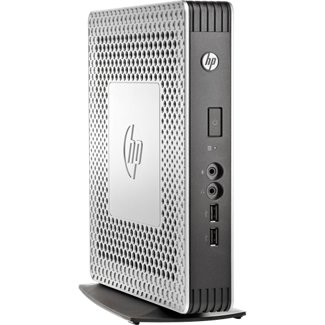AMD Tips Hand on G-Series "Kabini" Performance, Hints at ARM Embedded CPUs
AMD's upcoming Kabini SoC sits at the heart of the PlayStation 4, the next-generation Xbox 720 (unofficially), and is central to the company's tablet and laptop plans for 2013. It's also a key component of Sunnyvale's new embedded strategy, which is part of what makes the new crop of embedded products AMD announced today rather interesting. The new SoCs run the gamut from 9W - 25W and the majority are quad core.
The new embedded chips are as follows:
 These performance figures imply that Kabini is ~8% faster than Brazos clock-for-clock and core-for-core. That's within the 8-15% guidance AMD has given. There's no sign of the promised 9W quad-core yet, but a quad-core chip at 1.5GHz and 15W is an enormous improvement on Brazos' dual-core 19W design.
These performance figures imply that Kabini is ~8% faster than Brazos clock-for-clock and core-for-core. That's within the 8-15% guidance AMD has given. There's no sign of the promised 9W quad-core yet, but a quad-core chip at 1.5GHz and 15W is an enormous improvement on Brazos' dual-core 19W design.
These chips look good. The combination of quad-cores, higher clocks, and stronger GPUs could make Kabini the Goldilocks solution that the tablet industry currently lacks. The gap is best illustrated by the differences between Microsoft's Surface and the Surface Pro. The standard Surface is lighter, easier to carry, and fits the hand better, but performance isn't very good. The Surface Pro packs better features, but it's noticeably thicker and requires an active fan.
The G-56TN Brazos chip has found some use in embedded solutions from vendors like HP; the updated Kabini version should be useful in a wider range of products. Power consumption and clock speed targets between the embedded products and hypothetical mobile chips should be fairly close -- the challenges of squeezing a chip + associated I/O technology are identical whether you slip the final product into a tiny handheld or a tiny case.
The ARM tease comes, amusingly, from the product logo. See the small "X" in the lower-right-hand corner? Analysts have jumped on it, believing that it's a marker that denotes an x86 processor. AMD has actually admitted that it intends to bring embedded chips to market for ARM as well, Arun Iyengar, General Manager of AMD's Embedded Solutions Group, told Engadget, "Ultimately, we're going to have x86 and ARM in our product portfolio."
That, however, isn't going to happen in the next 6-9 months. The tablet performance details are more interesting. Kabini is, in our opinion, shaping up like a product with real potential. Hopefully it'll be enough to spark renewed interest in Windows 8 tablets and convertible PCs when it launches later this year.
The new embedded chips are as follows:
- GX-420CA (quad-core, 2.0GHz, Radeon 8400E @ 600MHz, 25W TDP)
- GX-415GA (quad-core, 1.5GHz, Radeon 8330E @ 500MHz, 15W TDP)
- GX-217GA (dual-core, 1.65GHz, Radeon 8280E @ 450MHz, 15W TDP)
- GX-210HA (dual-core, 1.0GHz, Radeon 8210E @ 300MHz, 9W TDP)
- GX-416RA (quad-core, 1.6GHz, 15W, no GPU)
 These performance figures imply that Kabini is ~8% faster than Brazos clock-for-clock and core-for-core. That's within the 8-15% guidance AMD has given. There's no sign of the promised 9W quad-core yet, but a quad-core chip at 1.5GHz and 15W is an enormous improvement on Brazos' dual-core 19W design.
These performance figures imply that Kabini is ~8% faster than Brazos clock-for-clock and core-for-core. That's within the 8-15% guidance AMD has given. There's no sign of the promised 9W quad-core yet, but a quad-core chip at 1.5GHz and 15W is an enormous improvement on Brazos' dual-core 19W design. These chips look good. The combination of quad-cores, higher clocks, and stronger GPUs could make Kabini the Goldilocks solution that the tablet industry currently lacks. The gap is best illustrated by the differences between Microsoft's Surface and the Surface Pro. The standard Surface is lighter, easier to carry, and fits the hand better, but performance isn't very good. The Surface Pro packs better features, but it's noticeably thicker and requires an active fan.
The G-56TN Brazos chip has found some use in embedded solutions from vendors like HP; the updated Kabini version should be useful in a wider range of products. Power consumption and clock speed targets between the embedded products and hypothetical mobile chips should be fairly close -- the challenges of squeezing a chip + associated I/O technology are identical whether you slip the final product into a tiny handheld or a tiny case.
The ARM tease comes, amusingly, from the product logo. See the small "X" in the lower-right-hand corner? Analysts have jumped on it, believing that it's a marker that denotes an x86 processor. AMD has actually admitted that it intends to bring embedded chips to market for ARM as well, Arun Iyengar, General Manager of AMD's Embedded Solutions Group, told Engadget, "Ultimately, we're going to have x86 and ARM in our product portfolio."
That, however, isn't going to happen in the next 6-9 months. The tablet performance details are more interesting. Kabini is, in our opinion, shaping up like a product with real potential. Hopefully it'll be enough to spark renewed interest in Windows 8 tablets and convertible PCs when it launches later this year.

